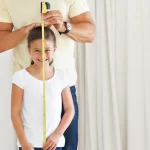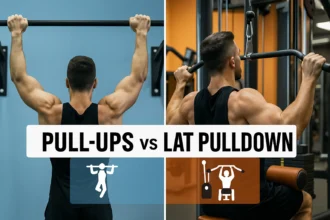If you’ve ever watched a gymnastics rings routine, one thing probably stood out immediately: the arms. Ring specialists often have thick, dense biceps that rival bodybuilders, yet during their routines, they almost never bend their arms.
So how does that make sense?
The answer lies in straight-arm strength training, a cornerstone of gymnastics preparation that develops muscle in a very different way than traditional gym workouts.
Why Straight-Arm Training Is So Effective for Biceps Growth
At first glance, it seems counterintuitive. No curling. No elbow flexion. No classic hypertrophy movements.
Yet straight-arm exercises place the biceps and brachialis under constant isometric contraction. When the elbows are locked and the arms are loaded, these muscles fire automatically to stabilize and protect the joint.
This is one of their primary functions.
Even more important: Isometric contractions build muscle extremely well, especially when the muscle is under stretch. The more stretched the muscle is while contracting, the stronger the growth stimulus.
That’s why gymnasts develop such dense arms. Their biceps aren’t just shortening, they’re working hard to hold position, often for long durations, under high tension.
How to Sculpt Biceps With Straight-Arm Exercises
Gymnasts follow a very clear progression that teaches the joints how to handle load before pushing intensity. Following them patiently is how you build thick, durable arms.
Step 1: Learn the Correct Straight-Arm Position
Before you think about strength, you need to understand alignment. Straight-arm training only works if your joints are positioned correctly.
Start in a kneeling support or push-up position and rotate your elbows outward so the inner elbow crease faces forward. Your arms stay fully locked, palms facing slightly outward rather than inward.
This position does three important things at once:
- It stabilizes the shoulder joint
- It places the humerus in its strongest alignment
- It automatically activates the biceps and brachialis
You’ll feel the difference immediately. The arms feel “alive,” not passively locked.
From here, add wrist mobilizations and simple supported holds, such as push-up supports or parallel bar supports. These teach your body how to carry load through straight arms without collapsing into the joints.
If you have hyperextended elbows:
This is very common in gymnastics and not a dealbreaker. The key is intent. Never hang passively into lockout. Instead, actively contract your biceps and brachialis to “pull” the elbow into a controlled position. Adaptation may take longer, but strength is still very achievable.
Step 2: Elastic Band Straight-Arm Exercises
Elastic bands are the safest and smartest entry point into straight-arm strength. They provide resistance without shock loading the joints, allowing your connective tissues to adapt.
One of the most effective drills is the band straight-arm front raise.
Anchor the band behind you and step forward until there is already tension. With elbows locked and palms facing forward, raise your arms slowly in front of you, then lower them with control.
Even at low resistance, you’ll feel tension building in the elbows, biceps, and shoulders. That’s exactly what you want.
Typical guidelines:
- 15–30 controlled reps
- Follow with a 10–30 second static hold
For extra benefit, include small curls under constant tension. These are subtle, controlled micro-bends and extensions where the band is always pulling back. The goal isn’t to curl—it’s to keep the biceps active in a stretched position while the elbows stay stable.
This is especially valuable if you have hyperextension, as it teaches your elbows how to resist unwanted movement under load.
Step 3: Dumbbell Straight-Arm Strength
Once bands feel comfortable, dumbbells allow you to add load while keeping movements controlled and joint-friendly.
A classic gymnastics conditioning drill here is the planche press with dumbbells.
Lie on your back, or better yet, in a hollow body position to engage the core. Hold the dumbbells with palms facing forward and arms fully locked. Raise the arms to about 45 degrees, then lower slowly.
This movement mimics the shoulder angle and straight-arm demand of planche training while directly loading the biceps isometrically.
Start light. Very light.
- 15 controlled reps or
- 10–30 second static holds
If you elevate your upper body slightly, you can increase the range of motion and add controlled negatives. Over time, gradually increase weight but only as long as elbow control remains solid.
Step 4: Closed Kinetic Chain Training (Planche Leans)
This is where straight-arm training starts to feel serious.
Closed kinetic chain exercises where your hands stay fixed, introduce much higher straight-arm demands. The simplest and most scalable option is the planche lean.
Start in a push-up position with:
- Core tight and pelvis slightly tucked
- Glutes engaged
- Scapula depressed and protracted
Rotate your hands slightly outward, or use a supinated grip if biceps development is your main goal. With elbows locked, lean your shoulders forward as far as you can while maintaining control.
At first, the lean will be minimal. As strength improves, you’ll be able to shift farther forward, dramatically increasing the load on your arms.
You can train these as:
- Controlled reps
- Static holds (10–30 seconds)
- Or a combination of both
This exercise alone can build impressive straight-arm biceps strength when performed consistently and patiently.
Step 5: Ring Progressions (The Peak of Straight-Arm Strength)
The highest expression of straight-arm strength happens on the rings.
Even a basic support hold with rings turned out (RTO) is a major milestone. It forces constant biceps activation while the connective tissues stabilize the elbow and shoulder under unpredictable load.
From there, progress into:
- Ring flies, starting kneeling and gradually lowering body angle
- Static holds and presses in front of, beside, and behind the body
- Dynamic variations, once 30-second holds are solid
Ultimately, straight-arm skills like the back lever, straddle planche, Maltese, and Iron Cross represent the maximum demand. At this level, the biceps are no longer just assisting, they are fighting continuously to protect the elbows under extreme force.
Why This Approach Works
What makes these exercises so effective is how the load is applied. The biceps spend long periods contracting isometrically while stretched, which creates dense, durable muscle rather than short-lived pump.
Just as importantly, this progression respects the reality of connective tissue adaptation. Muscles adapt quickly. Tendons do not. Gymnasts succeed because they train both.
If you follow the same system, starting light, building patiently, you can completely transform both how you look and how you move.













